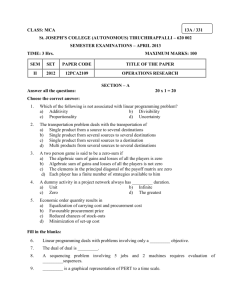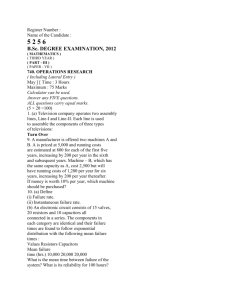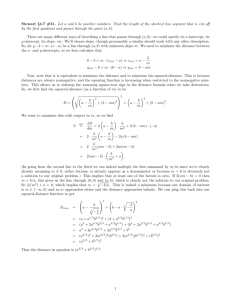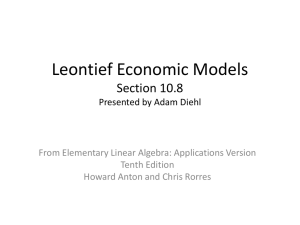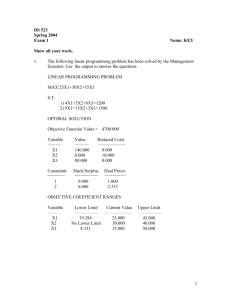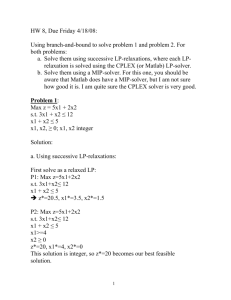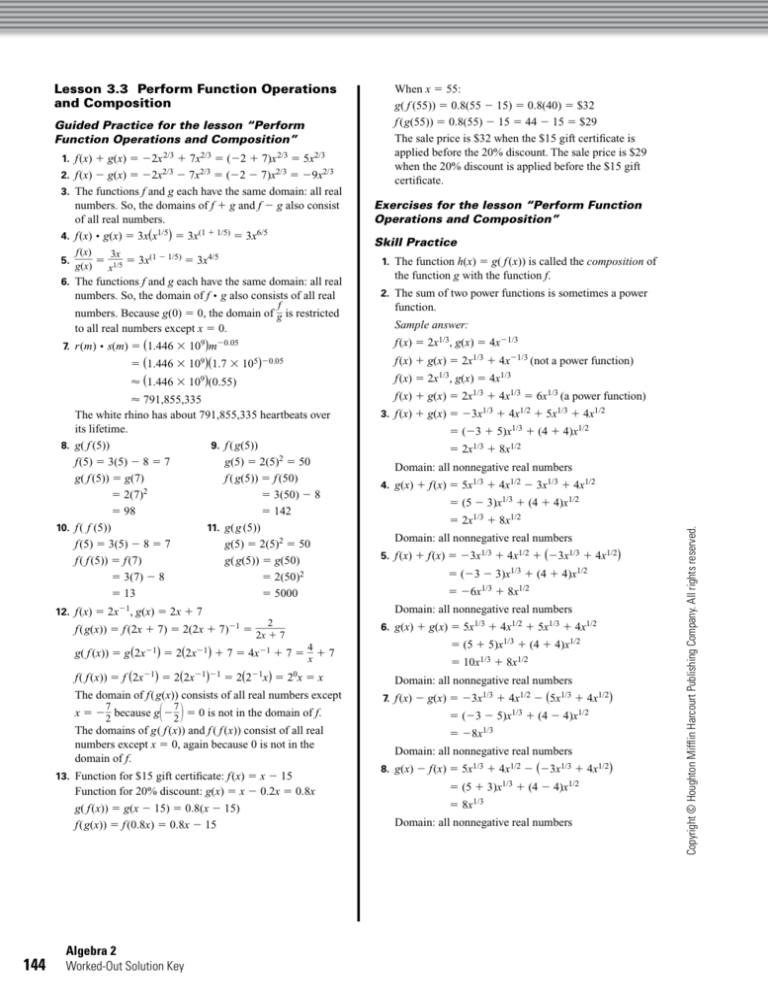
Guided Practice for the lesson “Perform
­Function Operations and Composition”
1. f(x) 1 g(x) 5 22x 2/3 1 7x2/3 5 (22 1 7)x 2/3 5 5x2/3
2. f(x) 2 g(x) 5 22x2/3 2 7x2/3 5 (22 2 7)x2/3 5 29x2/3
3.The functions f and g each have the same domain: all real
numbers. So, the domains of f 1 g and f 2 g also consist
of all real numbers.
4. f(x) p g(x) 5 3x(x1/5) 5 3x(1 1 1/5) 5 3x6/5
f(x)
g(x)
3x
x
5. } 5 }
1/5 5 3x(1 2 1/5) 5 3x4/5
6.The functions f and g each have the same domain: all real
numbers. So, the domain of f p g also consists of all real
f
numbers. Because g(0) 5 0, the domain of }g is restricted
Exercises for the lesson “Perform F
­ unction
Operations and Composition”
Skill Practice
1.The function h(x) 5 g( f (x)) is called the composition of
the function g with the function f.
2.The sum of two power functions is sometimes a power
function.
to all real numbers except x 5 0.
Sample answer:
7. r(m) p s(m) 5 (1.446 3 109)m20.05
f (x) 5 2x1/3, g(x) 5 4x21/3
5 (1.446 3 109)(1.7 3 105)20.05
f(x) 1 g(x) 5 2x1/3 1 4x21/3 (not a power function)
ø (1.446 3 109)(0.55)
f(x) 5 2x1/3, g(x) 5 4x1/3
ø 791,855,335
The white rhino has about 791,855,335 heartbeats over
its lifetime.
8. g( f (5))
9. f (g(5))
f(5) 5 3(5) 2 8 5 7 g(5) 5 2(5)2 5 50
g( f (5)) 5 g(7) f ( g(5)) 5 f (50)
5 2(7)2
5 3(50) 2 8
5 98
5 142
10. f ( f (5))
11. g(g (5))
f (5) 5 3(5) 2 8 5 7 g(5) 5 2(5)2 5 50
f ( f (5)) 5 f (7) g( g(5)) 5 g(50)
5 3(7) 2 8
5 2(50)2
5 13
5 5000
21
f (g(x)) 5 f (2x 1 7) 5 2(2x 1 7)
2
5}
2x 1 7
4
f( f (x)) 5 f (2x
) 5 2(2x )
21 21
5 2(2 x) 5 2 x 5 x
21
0
The domain of f (g(x)) consists of all real numbers except
7
7
2 5 0 is not in the domain of f.
x 5 2 }2 because g 2}
1 2
The domains of g( f (x)) and f ( f (x)) consist of all real
numbers except x 5 0, again because 0 is not in the
domain of f.
13. Function for $15 gift certificate: f(x) 5 x 2 15
Function for 20% discount: g(x) 5 x 2 0.2x 5 0.8x
g( f (x)) 5 g(x 2 15) 5 0.8(x 2 15)
f(g(x)) 5 f (0.8x) 5 0.8x 2 15
Algebra 2
Worked-Out Solution Key
3. f (x) 1 g(x) 5 23x1/3 1 4x1/2 1 5x1/3 1 4x1/2
5 (23 1 5)x1/3 1 (4 1 4)x1/2
5 2x1/3 1 8x1/2
Domain: all nonnegative real numbers
4. g(x) 1 f(x) 5 5x1/3 1 4x1/2 2 3x1/3 1 4x1/2
5 (5 2 3)x1/3 1 (4 1 4)x1/2
5 2x1/3 1 8x1/2
Domain: all nonnegative real numbers
5. f (x) 1 f(x) 5 23x1/3 1 4x1/2 1 (23x1/3 1 4x1/2)
5 (23 2 3)x1/3 1 (4 1 4)x1/2
5 26x1/3 1 8x1/2
6. g(x) 1 g(x) 5 5x1/3 1 4x1/2 1 5x1/3 1 4x1/2
g( f (x)) 5 g (2x21) 5 2(2x21) 1 7 5 4x21 1 7 5 }
x 1 7
21
f(x) 1 g(x) 5 2x1/3 1 4x1/3 5 6x1/3 (a power function)
Domain: all nonnegative real numbers
12. f(x) 5 2x21, g(x) 5 2x 1 7
144
When x 5 55:
g( f (55)) 5 0.8(55 2 15) 5 0.8(40) 5 $32
f (g(55)) 5 0.8(55) 2 15 5 44 2 15 5 $29
The sale price is $32 when the $15 gift certificate is
applied before the 20% discount. The sale price is $29
when the 20% discount is applied before the $15 gift
certificate.
5 (5 1 5)x1/3 1 (4 1 4)x1/2
5 10x1/3 1 8x1/2
Domain: all nonnegative real numbers
7. f (x) 2 g(x) 5 23x1/3 1 4x1/2 2 (5x1/3 1 4x1/2)
5 (23 2 5)x1/3 1 (4 2 4)x1/2
5 28x1/3
Domain: all nonnegative real numbers
8. g(x) 2 f(x) 5 5x1/3 1 4x1/2 2 (23x1/3 1 4x1/2)
5 (5 1 3)x1/3 1 (4 2 4)x1/2
5 8x1/3
Domain: all nonnegative real numbers
Copyright © Houghton Mifflin Harcourt Publishing Company. All rights reserved.
Lesson 3.3 Perform Function Operations
and Composition
9. f (x) 2 f (x) 5 23x1/3 1 4x1/2 2 (23x1/3 1 4x1/2)
5 (23 1 3)x
50
1/3
1/2
1 (4 2 4)x
4x2/3
4x
Domain of f: all real numbers
Domain: all nonnegative real numbers
10. g(x) 2 g(x) 5 5x1/3 1 4x1/2 2 (5x1/3 1 4x1/2)
5 (5 2 5)x1/3 1 (4 2 4)x1/2
50
Domain: all nonnegative real numbers
11. B;
f (x) 1 g(x) 5 27x 2/3 2 1 1 2x2/3 1 6
5 (27 1 2)x 2/3 2 1 1 6
5 25x 2/3 1 5
5 20x(2/3 1 1/2)
5 20x7/16
f
f
Domain of } : all real numbers except x 5 0
g(x)
g(x)
5x1/2
5x
5 1
19. } 5 }
1/2
Domain of g: all nonnegative real numbers
g
Domain of }
g : all positive real numbers
20. g(23) 5 2(23)2 5 29
f (g(23)) 5 f (29) 5 3(29) 1 2 5 225
21. f (2) 5 3(2) 1 2 5 8
12. f (x) p g(x) 5 4x2/3 p 5x1/2
g( f (2)) 5 g(8) 5 282 5 264
22. f (29) 5 3(29) 1 2 5 225
225 2 2
27
Domain of f: all real numbers
h( f (29)) 5 h(225) 5 }
5 2 }
5
5
Domain of g: all nonnegative real numbers
23. h(8) 5 }
5 }
5
5
Domain of f p g: all nonnegative real numbers
13. g(x) p f(x) 5 5x
1/2
p 4x
2/3
822
6
6 2
g(h(8)) 5 g1 }
5 25 21 }
5 2 5 2 }
25
6
36
5 20x(1/2 1 2/3)
24. g(5) 5 252 5 225
5 20x7/6
5 2 }
h(g(5)) 5 h(225) 5 }
5
5
225 2 2
27
Domain of g: all nonnegative real numbers
25. f (7) 5 3(7) 1 2 5 23
Domain of f: all real numbers
f ( f (7)) 5 f (23) 5 3(23) 1 2 5 71
Domain of g p f: all nonnegative real numbers
14. f (x) p f(x) 5 4x2/3 p 4x2/3
Copyright © Houghton Mifflin Harcourt Publishing Company. All rights reserved.
f (x)
f (x)
18. } 5 }
5 1
2/3
5 16x(2/3 1 2/3)
4/3
6
24 2 2
5 2 }5
26. h(24) 5 }
5
6
2 }5 2 2
5 25 }
5
5 2 }
h(h(24)) 5 h1 2}
25
6
5 16x
16
27. g(25) 5 2(25)2 5 225
Domain of f: all real numbers
g(g(25)) 5 g(225) 5 2(225)2 5 2625
Domain of f p f: all real numbers
3
28. f (g(x)) 5 f (2x 2 7) 5 3(2x 2 7)21 5 }
2x 2 7
15. g(x) p g(x) 5 5x1/2 p 5x1/2
5 25x(1/2 1 1/2)
The domain of f(g(x)) consists of all real numbers except
5 25x
Domain of g: all nonnegative real numbers
x 5 }
2 because g1 }
2 25 0 is not in the domain of f.
Domain of g p g: all nonnegative real numbers
29. g( f (x)) 5 g(3x21) 5 2(3x21) 2 7 5 6x21 2 7 5 }
x 2 7
f (x)
g(x)
4x2/3
5x
4x(2/3 2 1/2)
7
Domain of f: all real numbers
3x21 1 4
Domain of g: all nonnegative real numbers
f
g
Domain of }
: all positive real numbers
5x1/2
4x
5x(1/2 2 2/3)
4
5x21/6
4
6
The domain of g( f(x)) consists of all real numbers except
x 5 0 because 0 is not in the domain of f.
4x1/6
5 }
5 }
16. } 5 }
1/2
5
5
g(x)
f (x)
7
5
4x
5 }
5 }
5 }
17. } 5 }
2/3
1/6
3x21
4
1
4
3
5 }
3
1 }
3 5 }
x 1 }3
30. h( f (x)) 5 h(3x21) 5 }
The domain of h( f (x)) consists of all real numbers except
x 5 0 because 0 is not in the domain of f.
3
25 21 }
2 7
31. g(h(x)) 5 g1 }
3 2
x14
2x 1 8
x14
2x 1 8 2 21
2x 2 13
2 7 5 }
5 }
5}
3
3
3
Domain of f: all real numbers
Domain of g: all nonnegative real numbers
The domain of g(h(x)) consists of all real numbers.
g
Domain of }
: all positive real numbers
f
32. h(g(x)) 5 h(2x 2 7) 5 }
5 }
3
3
2x 2 7 1 4
2x 2 3
The domain of h(g(x)) consists of all real numbers.
Algebra 2
Worked-Out Solution Key
145
33. f( f (x)) 5 f (3x21) 5 3(3x21)21 5 3(321x) 5 30x 5 x
44. C(x(t)) 5 C(50t) 5 60(50t) 1 750 5 3000t 1 750
The domain of f ( f (x)) consists of all real numbers except
x 5 0, because 0 is not in the domain of f.
C(x(5)) 5 3000(5) 1 750 5 15,750
x14
x 1 16
3
x 1 4 1 12
}
5 }
5 }
}
1 4
5
34. h(h(x)) 5 h1 }
3 2
x14
3
9
9
The domain of h(h(x)) consists of all real numbers.
35. g(g(x)) 5 g(2x 2 7) 5 2(2x 2 7) 2 7
a. g( f (x)) 5 g(x 2 15) 5 0.9(x 2 15)
5 4x 2 14 2 7 5 4x 2 21
The domain of g(g(x)) consists of all real numbers.
36.When performing f (4x), 4x should have been substituted
for x in the function f.
f (g(x)) 5 f (4x) 5 (4x)2 2 3 5 16x2 2 3
37. The product 4(x2 2 3) was not performed correctly.
g( f (x)) 5 g(x 2 2 3) 5 4(x 2 2 3) 5 4x 2 2 12
38. A;
3
g( f (x)) 5 g(7x2) 5 3(7x 2)22 5 3(722x24) 5 }
4
49x
39. Sample answer: f (x) 5 x, g(x) 5 x21
) 5 g(x)
x
b. f (g(x)) 5 f(0.9x) 5 0.9x 2 15
f (g(85)) 5 0.9(85) 2 15 5 76.5 2 15 5 61.50
The sale price is $61.50 when the 10% discount is
applied before the $15 discount.
c. If the 10% discount is applied before the $15 discount,
you get a better deal. Your purchase will be $61.50
instead of $63.
5 x21
20 2 x 5 (6.4)r(x)
20 2 x
40. Sample answer:
5 r (x)
}
6.4
3}
f (x) 5 Ï
x , g(x) 5 x 1 2
3}
h(x) 5 f (g(x)) 5 f (x 1 2) 5 Ï
x 1 2
41. Sample answer:
4
, g(x) 5 3x 2
f (x) 5 }
x17
4
h(x) 5 f (g(x)) 5 f (3x ) 5 }
2
3x 1 7
42. Sample answer:
2
f (x) 5 x, g(x) 5 2x 1 9
h(x) 5 f (g(x)) 5 f (2x 1 9) 5 2x 1 9
Problem Solving
1.1w 0.734
43. r(w) 5 }
b(w) 2 d(w)
Distance from point D to point B:
x 2 1 122 5 c2
x 2 1 144 5 c2
}
Ïx2 1 144
5c
Distance 5 rate p time
}
5 (0.9)s(x)
Ïx 2 1 144
}
Ï
x 2 1 144
}
5 s(x)
0.9
}
20 2 x
Ï x 2 1 144
b. t(x) 5 r(x) 1 s(x) 5 }
6.4
1 }
0.9
c. 1.1w 0.734
5 }}
0.007w 2 0.002w
5}
0.005w
5 220w(0.734 2 1)
5 220w20.266
1.1w 0.734
r(w) 5 220w20.266
r(6.5) 5 220(6.5)20.266 ø 134
The breathing rate of a mammal that weighs 6.5 grams is
about 134 breaths per minute.
r(300) 5 220(300)20.266 ø 48.3
The breathing rate of a mammal that weighs 300 grams is
about 48.3 breaths per minute.
r (70,000) 5 220(70,000)20.266 ø 11.3
The breathing rate of a mammal that weighs 70,000 grams
is about 11.3 breaths per minute.
146
The sale price is $63 when the $15 discount is applied
before the 10% discount.
Distance 5 rate p time
21
21
g( f (85)) 5 0.9(85 2 15) 5 0.9(70) 5 63
46. a. Distance from point A to point D: 20 2 x
f (g(x)) 5 g( f (x))
f (x
45. Let x represent the regular price.
Function for $15 discount: f (x) 5 x 2 15
Function for 10% discount: g(x) 5 x 2 0.1x 5 0.9x
Algebra 2
Worked-Out Solution Key
Minimum
X=1.7044344 Y=16.325839
The value of x that minimizes t(x) is 1.7. This means
that to get to the ball in the shortest time, Elvis should
run along the beach 20 2 1.7 5 18.3 meters and then
swim out to the ball.
Copyright © Houghton Mifflin Harcourt Publishing Company. All rights reserved.
This number represents the cost ($15,750) of 5 hours of
production in the factory.
2
11}
1 3
}
47. a. f (1) 5
5 } 5 1.5
2
2
2
1.5 1 }
1.5
}
ø 1.417
f ( f (1)) 5 f (1.5) 5 2
2
1.417 1 }
1.417
}}
ø 1.414
f ( f ( f (1))) 5 f (1.417) 5
2
Mixed Review of Problem Solving for the
­lessons “Evaluate nth Roots and Use Rational
Exponents”, “Apply Properties of Rational
Exponents” and “Perform Function Operations
and Composition”
1. a. s(x) 5 x 2
π x2
x 2
b. c(x) 5 π 1 }
2 2 5 }
4
f( f ( f ( f (1)))) 5 f(1.414)
2
1.414 1 }
1.414
}}
ø 1.414214
5
π x 2
2
2. a. V 5 321(4π)21/2(S 3)1/2
b. f ( f ( f ( f ( f (1))))) 5 f(1.414214)
2
1.414214 1 }
1.414214
ø 1.414214
5 }}
2
}
Ï 2 ø 1.414213562
You need to compose the function
3 times in order for
}
the result to approximate Ï 2 to three decimal places.
You need to compose the function
4 times in order for
}
the result to approximate Ï
2 to six decimal places.
Graphing Calculator Activity for the
­lesson “Perform Function Operations and
­Composition”
1.
Copyright © Houghton Mifflin Harcourt Publishing Company. All rights reserved.
Y1=X3+5X-3
Y2=-3X2-X
Y3=Y2+Y1
Y4=
Y5=
Y6=
Y7=
Y7=
2.
Y3(7)
221
Y3(-8)
SÏS
6π
5}
1/2
πS
Ï
5}
6π
S
}
79
}
6π Ïπ(79)
ø 66
b. V 5 }
The volume of the candlepin bowling ball is about 66
cubic inches.
232
}
c. V 5 }
6π Ïπ(232)
ø 332
The volume of the ball is about 332 cubic inches.
0.0277777778
f (g(x)) 5 0.03x 2 100,000
g( f (x)) 5 0.03(x 2 100,000)
The composition g( f (x)) represents your bonus if x >
100,000, because the bonus must be applied after $100,000
is subtracted.
4. a. V 5 πr 2h 5 3.14x 2(5) 5 15.7x 2
Y1=5X3-3X2
Y2=-2X2-5
Y3=Y2-Y1
Y4=
Y5=
Y6=
Y7=
Y7=
Y3(2)
-41
15.7x 2
b. }
5 128(8.8)
2
15.7x 2 5 2252.8
c. 15.7x 2 5 2252.8
Y1=2X2+7X-2
Y2=X-6
Y3=Y1(Y2)
Y4=
Y5=
Y6=
Y7=
Y7=
)
}
3. f (x) 5 x 2 100,000, g(x) 5 0.03x
4.
S 3/2
3(2π
5 }
1/2
d. The surface area of the 10-pin bowling ball is about 3
times that of the candlepin bowling ball. The volume
of the 10-pin bowling ball is about 5 times that of the
candlepin bowling pin.
Y1=X^(1/3)
Y2=9X
Y3=Y1/Y2
Y4=
Y5=
Y6=
Y7=
Y7=
3.
π 4 5 1 1 2 }
4 2 x2 ø 0.21x 2
c. r(x) 5 x 2 2 }
Y3(5)
-7
x 2 ø 143.49
}
x ø 6Ï143.49
x ø 612
The radius of the pool is about 12 feet.
Algebra 2
Worked-Out Solution Key
147
3
Volume
Hose output
5
filled
per hour
p Time
3
675.84 5 232t
2.9 ø t
4
5. Sample answer:
1
f(x) 5 }x
f(x) 5 x
x 25 x f( f(x)) 5 f 1 }
1
2 12
1/2
Evaluate 16
5
52 Divide 4 by 2.
5 32
Evaluate 25.
and 4 .
3x 1 2 2 2
1 2
5 31 }
3 2
5}
3
5 x 2 2 1 2
5}
3
5 x
5x
G
Power of a quotient property
5 (4
)
5 4(1/2 p 5)
Power of a power property
5 45/2
Multiply }
2 by 5.
1/2 5
x22
3x
x
25
22
y 5 f(x)
21
2 }2
1
1
1
4
7
0
}
1
2
1
(0, 1), (1, 7)
y
721
y 2 1 5 6(x 2 0)
y 2 1 5 6x
(1, 7)
6
m5}
1 2 0 5 6
1
( 2, 4)
1
(25, 21)
(4, 2 ) (7, 1)
(1, 0)
g
x
(1, 0) 6
y 2 y1 5 m(x 2 x1)
Divide 16 by 4.
1
(22, 2 2 )
1
(2 2 , 22)
(21, 25)
f
y 5 6x 1 1
4
g(x) 5 6x 1 1
4
2. b. You can graph the inverse of a function by reflecting it
in the line y 5 x.
5 32
7.
V 5 }3 πr 3
Evaluate 45/2.
900 5 }
3 (3.14)r 3
3. b. In words, g is the function that multiplies x by 6 and
then adds 1.
900 ø 4.19r 3
214.8 ø r 3
6.0 ø r
f (g(x)) 5 f (6x 1 1)
g( f (x)) 5 g1 }
6 2
x21
6x 1 1 2 1
5 61 }
1 1
6 2
x21
The radius of the sphere is about 6.0 inches.
5 }
6
Lesson 3.4 Use Inverse Functions
5 }
6
5x2111
5 x
5x
Investigating Algebra Activity for the lesson
“Use Inverse Functions”
1. a. f (x) 5 3x 1 2
22
21
0
1
2
y 5 f (x)
24
21
2
5
8
120
1
m5}
5 2 2
5 }
3
y 2 y1 5 m(x 2 x1)
y
1
3
y 2 0 5 } (x 2 2)
6
(0, 2)
(24, 22)
(22, 24)
f
Algebra 2
Worked-Out Solution Key
(1, 5)
(8, 2)
(5, 1)
g
(21, 21)
3
2 x x
1. c. f(x) 5 4 2 }
y 5 f (x)
(4, 0), (1, 2)
(2, 8)
(2, 0) 6
6x
If f (g(x)) 5 x and g( f (x)) 5 x, then the function is
indeed the inverse of the original function.
x
(2, 0), (5, 1)
148
g( f (x)) 5 g(3x 1 2)
16 1/2 5
161/2 5
5 }
}
4
41/2
2
x22
6
1. b. f(x) 5 }
1/2
Yes, there is another set of steps you could use to simplify
the expression. For example:
F1
f (g(x)) 5 f 1 }
3 2
x21
4 5
161/2 5
}
5 }
2 1/2
4
2
x22
If f (g(x)) 5 x and g( f (x)) 5 x, then the function is
indeed the inverse of the original function.
f( f(x)) 5 f(x) 5 x
6. Sample answer:
1
g(x) 5 }
3
fill }
5 of the pool.
1
3. a. In words, g is the function that subtracts 2 from x then
divides the result by 3.
It will take a total of 8.8 1 2.9, or 11.7 hours to
y 5 }
3
2. a. You can graph the inverse of a function by reflecting it
in the line y 5 x.
}
(2252.8) 5 (104 1 128) p t
10
x22
x
220
2
m5}
1 2 4 5 2 }3
2
0
2
7
4
1
y 2 0 5 2 }3 (x 2 4)
4
(25, 6)
(22, 4)
(4, 22)
(22, 7)
(0, 4)
1
(1, 2)
(2, 1)
6
22 25
y
g
y 2 y1 5 m(x 2 x1)
22
(7, 22)
(4, 0)
x
1
(6, 25)
f
Copyright © Houghton Mifflin Harcourt Publishing Company. All rights reserved.
1
4
d. }5 2 }
2 5 }
10




